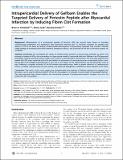| dc.contributor.author | Polizzotti, Brian D. | |
| dc.contributor.author | Arab, Shima | |
| dc.contributor.author | Kühn, Bernhard | |
| dc.date.accessioned | 2013-03-08T17:12:20Z | |
| dc.date.issued | 2012 | |
| dc.identifier.citation | Polizzotti, Brian D., Shima Arab, and Bernhard Kühn. 2012. Intrapericardial delivery of gelfoam enables the targeted delivery of periostin peptide after myocardial infarction by inducing fibrin clot formation. PLoS ONE 7(5): e36788. | en_US |
| dc.identifier.issn | 1932-6203 | en_US |
| dc.identifier.uri | http://nrs.harvard.edu/urn-3:HUL.InstRepos:10381367 | |
| dc.description.abstract | Background: Administration of a recombinant peptide of Periostin (rPN) has recently been shown to stimulate cardiomyocyte proliferation and angiogensis after myocardial infarction (MI). However, strategies for targeting the delivery of rPN to the heart are lacking. Intrapericardial administration of drug-eluting hydrogels may provide a clinically viable strategy for increasing myocardial retention, therapeutic efficacy, and bioactivity of rPN and to decrease systemic re-circulation. Methods and Results: We investigated the ability of intrapericardial injections of drug-eluting hydrogels to deliver and prolong the release of rPN to the myocardium in a large animal model of myocardial infarction. Gelfoam is an FDA-approved hemostatic material commonly used in surgery, and is known to stimulate fibrin clot formation. We show that Gelfoam disks loaded with rPN, when implanted within the pericardium or peritoneum of mammals becomes encapsulated within a non-fibrotic fibrin-rich hydrogel, prolonging the in vitro and in vivo release of rPN. Administration into the pericardial cavity of pigs, following a complete occlusion of the left anterior descending artery, leads to greater induction of cardiomyocyte mitosis, increased cardiomyocyte cell cycle activity, and enhanced angiogenesis compared to direct injection of rPN alone. Conclusions: The results of this study suggest that intrapericardial drug delivery of Gelfoam, enhanced by triggered clot formation, can be used to effectively deliver rPN to the myocardium in a clinically relevant model of myocardial infarction. The work presented here should enhance the translational potential of pharmaceutical-based strategies that must be targeted to the myocardium. | en_US |
| dc.language.iso | en_US | en_US |
| dc.publisher | Public Library of Science | en_US |
| dc.relation.isversionof | doi:10.1371/journal.pone.0036788 | en_US |
| dc.relation.hasversion | http://www.ncbi.nlm.nih.gov/pmc/articles/PMC3349650/pdf/ | en_US |
| dash.license | LAA | |
| dc.subject | Biology | en_US |
| dc.subject | Biotechnology | en_US |
| dc.subject | Bioengineering | en_US |
| dc.subject | Biomedical Engineering | en_US |
| dc.subject | Medical Devices | en_US |
| dc.subject | Biomaterials | en_US |
| dc.subject | Model Organisms | en_US |
| dc.subject | Animal Models | en_US |
| dc.subject | Engineering | en_US |
| dc.subject | Materials Science | en_US |
| dc.subject | Material by Attribute | en_US |
| dc.subject | Intelligent Materials | en_US |
| dc.subject | Porous Materials | en_US |
| dc.subject | Smart Materials | en_US |
| dc.subject | Material by Structure | en_US |
| dc.subject | Composite Materials | en_US |
| dc.subject | Polymers | en_US |
| dc.subject | Natural Materials | en_US |
| dc.subject | Medicine | en_US |
| dc.subject | Cardiovascular | en_US |
| dc.subject | Myocardial Infarction | en_US |
| dc.title | Intrapericardial Delivery of Gelfoam Enables the Targeted Delivery of Periostin Peptide after Myocardial Infarction by Inducing Fibrin Clot Formation | en_US |
| dc.type | Journal Article | en_US |
| dc.description.version | Version of Record | en_US |
| dc.relation.journal | PLoS ONE | en_US |
| dash.depositing.author | Polizzotti, Brian D. | |
| dc.date.available | 2013-03-08T17:12:20Z | |
| dc.identifier.doi | 10.1371/journal.pone.0036788 | * |
| dash.contributor.affiliated | Polizzotti, Brian | |


